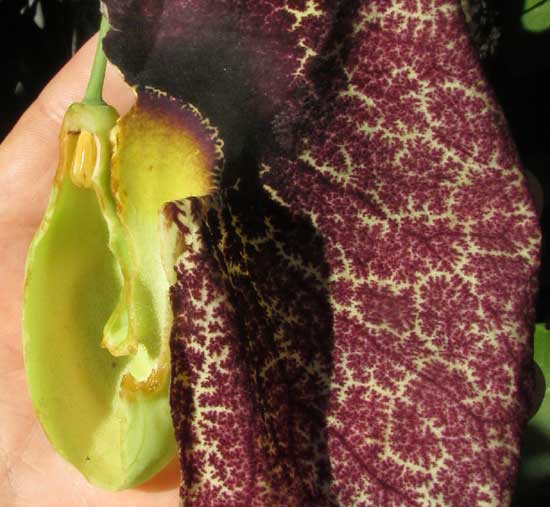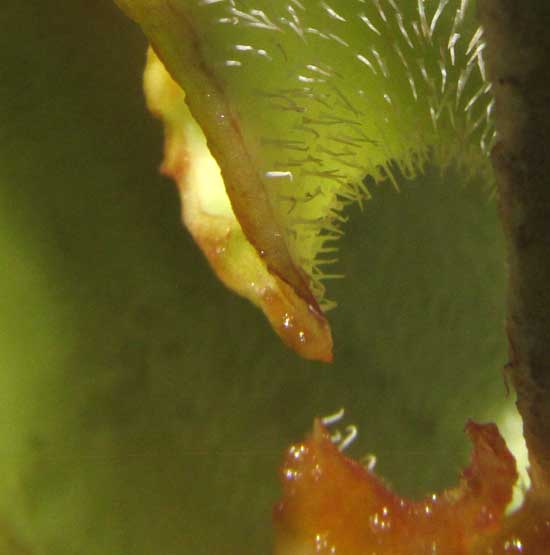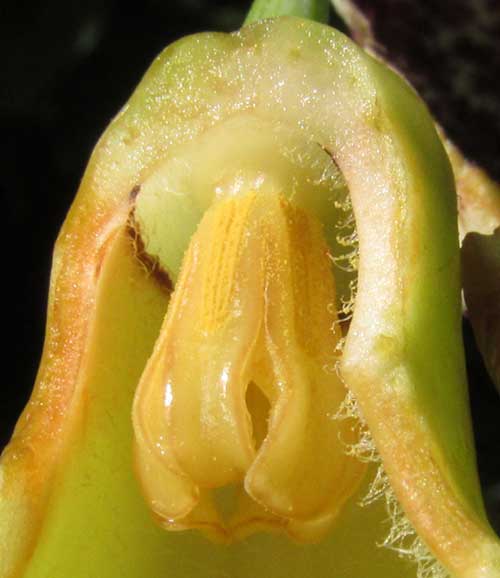Excerpts from Jim Conrad's
Naturalist Newsletter
from the November 12, 2017 Newsletter, with notes taken in mid October near Tepotzlán, Morelos state, MÉXICO
Elevation about 5315 ft (1620m), at 18°59′07″N 99°05′59″W
BRAZILIAN DUTCHMAN'S PIPE

During my mid-October visit with a friend near Tepotzlán, Morelos, in the uplands just south of Mexico City, one of the most spectacular blossoming plants in my friend's garden was a woody, evergreen twining climber spectacularly covering a wall. One of many blossoms is shown above.
At the right in that picture is an unopened flower. The yellow hole in the opened flower curves downward behind the flaring purple-and-white part forming a cylindrical tube, which then makes a U-turn upward. By tearing away one side of the tube and the corolla-like part, you get a better idea of the flower's structure, as seen below:

You might recognize this as an amazingly large-flowered specimen of the group of vines known as Dutchman's pipes, or birthworts, genus Aristolochia, often grown in gardens, and with native species occurring in much of North America and the tropics. This giant-flowered species is ARISTOLOCHIA GRANDIFLORA, commonly called Brazilian Dutchman's Pipe or Giant Pelican Flower. It's a member of the Dutchman's Pipe or Birthwort Family, the Aristolochiaceae, native to Central and South America, but planted in the tropics and subtropics worldwide.
Instead of the flowers consisting of the usual calyx and corolla, they produce a corolla-like calyx, or perianth. The perianth's unusual U-shaped tubes helps the flower with its pollination. The blossom's strong fragrance entice insects, mostly flies, to enter the yellow opening, and descend the tube. In the above picture you can see that the tube constricts at its bottom, then opens into a larger chamber. This makes it harder for the pollinator to find the way out, so the pollinator spends a lot of time wandering around depositing pollen from previously visited blossoms, and gathering pollen to leave in the next flower visited. Making it even harder for the pollinator to leave, sharp hairs on the perianth's inner surface point downward, always encouraging the pollinator to continue toward the pollen, but discouraging attempts to leave. Below, you can see downward-pointing hairs at the perianth's constriction:

Aristolochia sexual parts also are somewhat unusual, in that the six stamens group around the style and are fused with it, forming the interesting structure shown below:

North America's native Dutchman's pipe species are known as important hosts for Pipevine Swallowtail butterfly larvae. The Brazilian Dutchman's Pipe is a threat to this butterfly. Pipevine Swallowtails lay their eggs on its foliage, the eggs hatch, and the tiny larvae crawl around eating the leaves voraciously, and then die after about three days because the leaves are toxic.
Often the name birthwort is applied to Aristolochia species. In fact, the genus name is derived from the Greek words aristos meaning "best," and locheia meaning childbirth. That's because some people see the flower structure of certain Aristolochia species as resembling a human fetus in the womb, and in the past the vines were used medicinally to treat pain and infections associated with childbirth.
The Dutchman's pipe name result from the flowers' shape resembling the meerschaum pipes once common in the Netherlands and northern Germany.